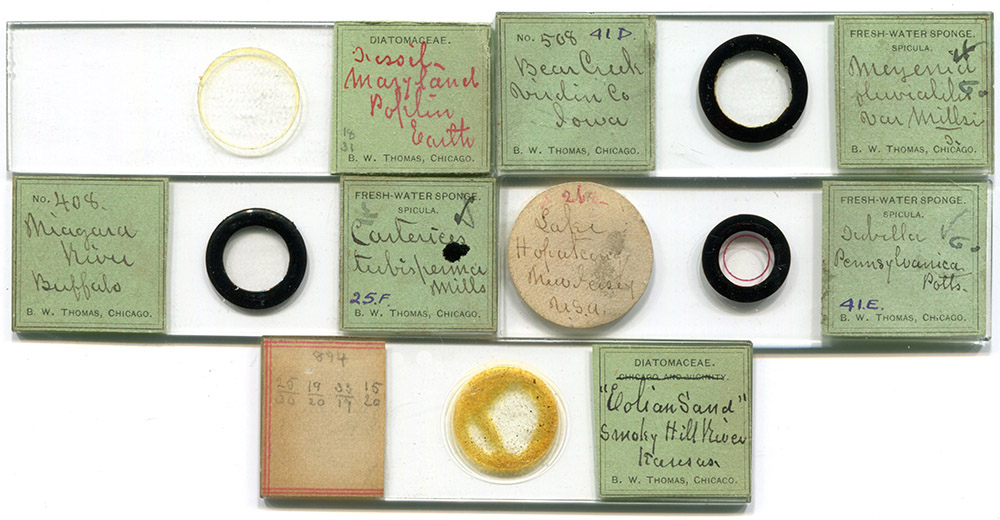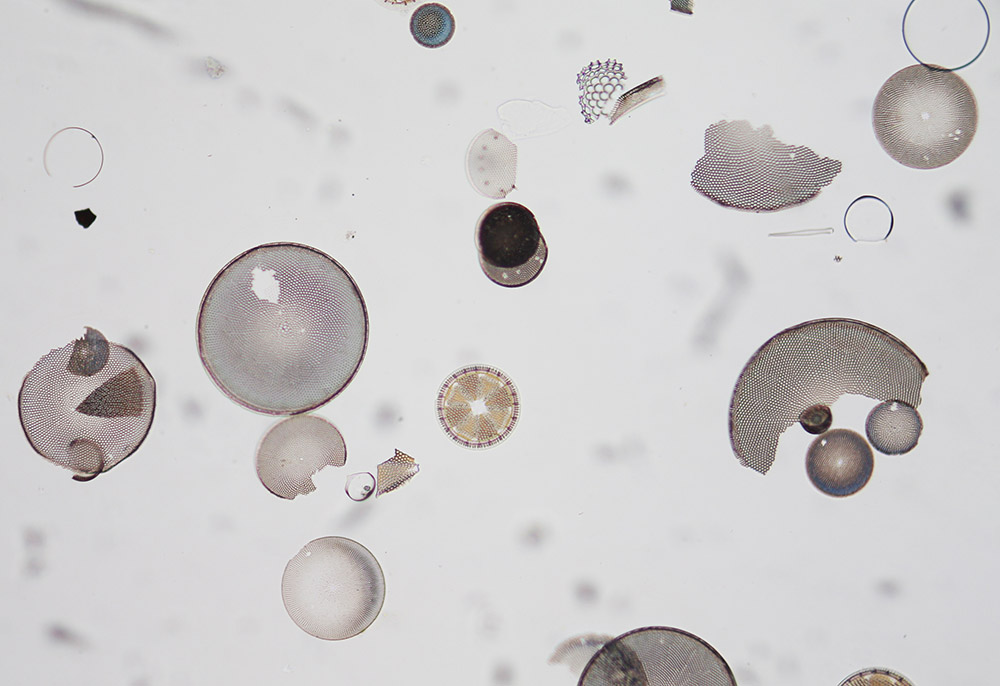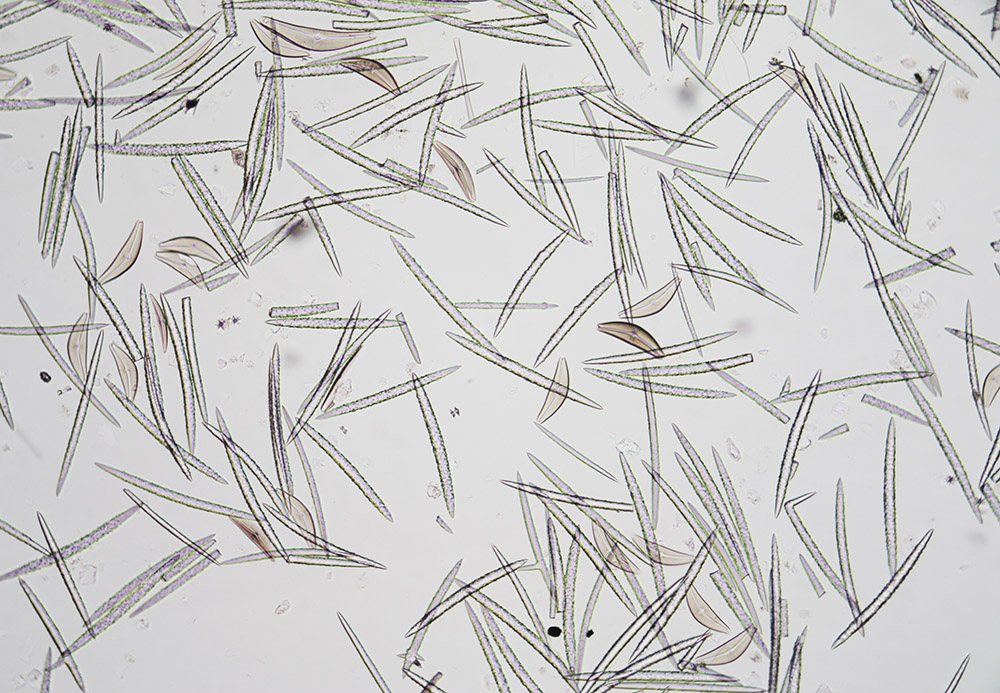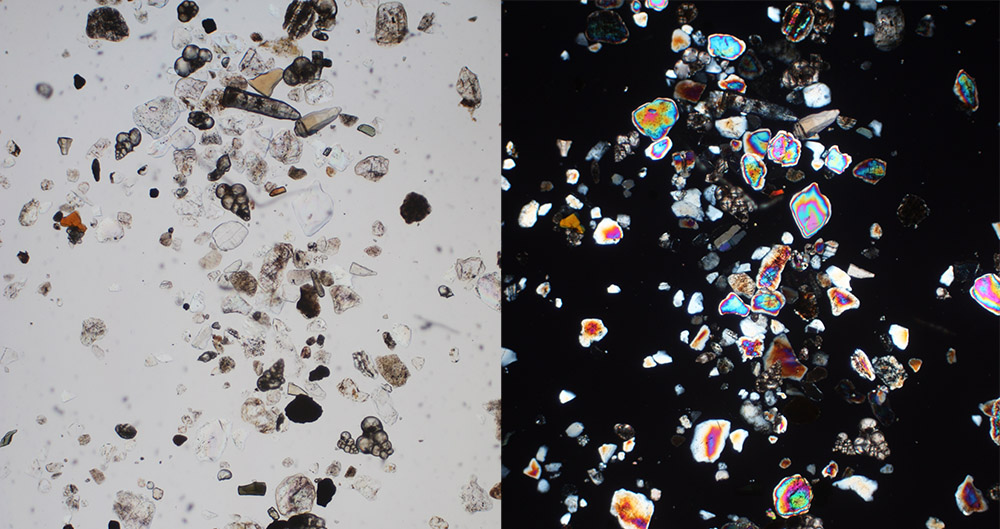Benjamin Walden Thomas, 1821 - 1905
by Brian Stevenson
last updated December, 2020
A career of owning lumber mills in the growing city of Chicago enabled B.W. Thomas to retire when he was only 50 years old. He then devoted a considerable amount of time to microscopic investigations of life in his area of North America, with particular focus on diatoms and freshwater sponges.
Microscope slides by Thomas carry labels that are printed with his name, address, and type of specimen (Figure 1). Also see B. Bracegirdle’s Microscopical Mounts and Mounters, Plate 35, slides L and M.
An 1894 biography of Benjamin Thomas, in a book on Chicago industrialists, included, “Mr. Thomas has always been of a scientific turn of mind and holds an enviable position among leading microscopists, having called the attention of scientists to important facts which had not previously been discovered, but which are now accepted as adding much to the sum of the world's knowledge, ranking him among those to whom honor is due, an honor which has been manifested by the concurrent opinion of scientists, not only in the United States, but in Great Britain and Germany. Mr. Thomas, early in the history of the Chicago Academy of Sciences, the Illinois State Microscopical Society and the American Society of Microscopists, became identified with those societies, and has been among the most active members of each, serving several years as vice-president of the Academy of Sciences and for one or more terms as president of the State Microscopical Society. He is also a member of the Royal Microscopical Society of England, and is widely recognized in American microscopical circles as an expert in that branch of science”.
A 1921 monograph on American freshwater sponges noted his considerable contributions to the field, “B.W. Thomas, of Chicago, a devotee to microscopy, did a good deal of collecting in northern Illinois for other workers, but not much writing”.

Figure 1.
Examples of microscope slides that were prepared by Benjamin W. Thomas, ca. 1880s-1890s. Note that he had labels printed for different types of specimens, such as “Diatomaceae” or “Fresh-water Sponge Spicules”. The lower slide is an exception, being a preparation of microscopic sand - presumably, this was an uncommon type of mount for Thomas, and he did not deem it necessary to have a specific label printed.

Figure 2.
Fossil diatoms from “Poplein Earth” (Nottingham, Maryland, USA), mounted by B.W. Thomas (see Figure 1). Photographed with a 10x objective lens and C-mounted digital SLR camera.

Figure 3.
Spicules from the freshwater sponge Meyenia fluviatilis var. Millsi, from Bear Creek, Hardin County, Iowa, prepared by B.W. Thomas (see Figure 1). This strew also contains a number of diatom frustules. Photographed with a 10x objective lens and C-mounted digital SLR camera.

Figure 4.
“Eolian sand” (windblown sand) from Smoky Hill River, Kansas, prepared by B.W. Thomas (see Figure 1). Photographed with a 5x objective lens and C-mounted digital SLR camera, using standard brightfield illumination (left) or crossed polarizing filters (right).
Benjamin Walden Thomas was born in Genesee County, New York, on August 13, 1821. Around the time of his twentieth birthday (August, 1841), he moved to Chicago, Illinois. He initially worked as a shop clerk, then, in 1843, he took a similar position with a lumber business. The following year, Thomas purchased that business, then expanded over the next three decades.
On October 6, 1848, he married Augusta A. Wilcox, daughter of a politically connected family. They had three daughters over the next twelve years.
According to his 1894 biographer, “Mr. Thomas was one of the founders of the first Odd Fellows lodge in Chicago, having become a member of the order at Buffalo in 1841, and on deciding to make Chicago his home, taking active steps to gather together the few Odd Fellows whom he found here, and applying to the Grand Lodge for a dispensation, Union Lodge No. 9 was instituted in 1844. Mr. Thomas is the only surviving member of this lodge. Mr. Thomas became also one of the organizers of the I.O.O.F. encampment in this city, and of the Sons of Temperance, of which he was the first and for many years the only Deputy Most Worthy Patriarch of the Northwest. Mr. Thomas was one of the organizers of the First Westminster Presbyterian Church in 1855, and of Christ Chapel Sunday-school - the first Union Sunday-school in Chicago or the Northwest - in 1843. In 1854 Mr. Thomas represented the (old) Eighth Ward as its alderman in the Common Council”.
The biographer continues, “On the breaking out of the war in 1861 (i.e., the U.S. Civil War), he was among the most active in arming, equipping and forwarding troops from Chicago, and was designated by the Union Defense Committee to give special attention to the equipment of recruits, gathering of munitions of war, and in every way facilitating prompt movements of regiments organized in northern Illinois. When the Seventy-second or ‘First Board of Trade’ regiment of Illinois Volunteer Infantry was organized he was commissioned as quartermaster of the regiment, and went into the field with it in July, 1862, remaining until compelled by sickness to resign in 1863”.
In 1871, Thomas sold his business, and delved into microscopy. He soon joined two local scientific societies, The Chicago Academy of Sciences and The Illinois State Microscopical Society. He served as President of the I.S.M.S. in 1881. In 1882, he joined The American Society of Microscopists, and later served as an officer of that society. He was elected Fellow of The Royal Microscopical Society in 1884.
As noted above, Thomas did not publish many papers on microscopy. One notable, descriptive paper on diatoms was entitled “Resolving Amphipleura pellucida with central light”, published in 1883. His other publications are essentially lists of diatom and sponge species that he identified in particular regions.
Benjamin Walden Thomas died in Chicago on January 1, 1905.

Figure 5.
An 1881 exchange offer by B.W. Thomas, from "The American Monthly Microscopical Journal".

Figure 6.
The first page of “Diatomaceae of Lake Michigan”, by B.W. Thomas and H.H. Chase, 1886. The three-page publication consists of a list of identified species.
Resources
The American Monthly Microscopical Journal (1881) Exchange offers from B.W. Thomas, Vol. 2, multiple issues
The American Monthly Microscopical Journal (1881) Illinois State Microscopical Society, Vol. 2, page 120
Bracegirdle, Brian (1998) Microscopical Mounts and Mounters, Quekett Microsocpical Club, London, pages 93 and 174, Plate 35-L and 35-M
Find-a-Grave (accessed March, 2020) Benjamin Walden Thomas, born August 13, 1821, died January 1, 1905, burial: Graceland Cemetery, Chicago, https://www.findagrave.com/memorial/157648402/benjamin-walden-thomas#view-photo=135322518
Hotchkiss, George Woodward (1894) Industrial Chicago Volume 6: The Lumber Interests, Goodspeed Publishing Company, Chicago, pages 36-37
Johnson, H.A., and B.W. Thomas (1884) Microscopic organisms in the bounder clays of Chicago and vicinity, Bulletin of the Chicago Academy of Science, Vol. 1, pages 35-40
Journal of the Royal Microscopical Society (1889) “Ordinary Fellows: … 1883 Thomas, Benjamin Walden. 27, Portland Block, Chicago, III., U.S.A.”
Potts, Edward (1887) Fresh Water Sponges, The Academy of Natural Sciences, Philadelphia
Proceedings of the American Society of Microscopists (1882) pages 8-9
Smith, Frank (1921) Distribution of the Fresh-Water Sponges of North America, State of Illinois, Urbana, Illinois
Thomas, B.W. (1883) Resolving Amphipleura pellucida with central light, The Microscope, Vol. 3, pages 9-11
Thomas, B.W., and H.H. Chase (1886) Diatomaceae of Lake Michigan, as Collected During the Last Sixteen Years from the Water Supply of the City of Chicago
Thomas, B.W. (1893) Diatomaceae of Minnesota Inter-glacial Peat. Twentieth Annual Report of the Minnesota Geological Survey, pages 290-320
U.S. census and other records, accessed through ancestery.com





